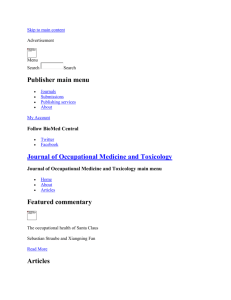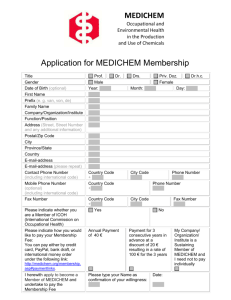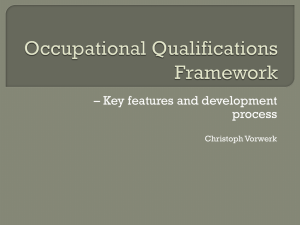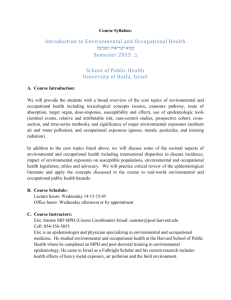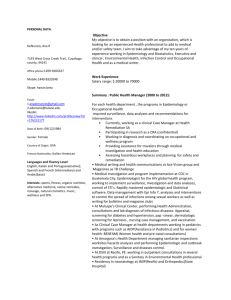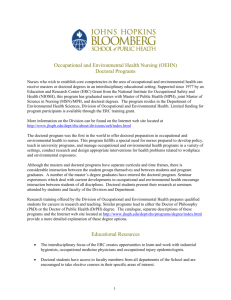Occupational_diseases2012
advertisement
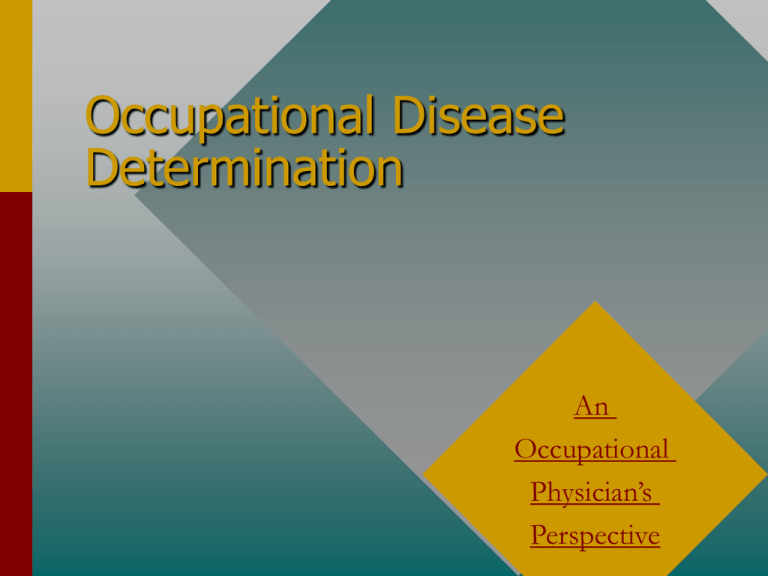
Occupational Disease Determination An Occupational Physician’s Perspective Dennis Stumpp, MD, MS • Board certified, residency trained Occupational medicine • Current Position – Staff physician Valley Medical Center Occupational Health Services - Auburn 30 hours/week – IME’s and consulting Legal Definitions RCW 51.08.100 "Injury." • "Injury" means a sudden and tangible happening, of a traumatic nature, producing an immediate or prompt result, and occurring from without, and such physical conditions as result therefrom. RCW 51.08.140 "Occupational disease." • "Occupational disease" means such disease or infection as arises naturally and proximately out of employment under the mandatory or elective adoption provisions of this title. Criteria For Allowance • Physician opinion more probable than not that work conditions are the cause of or have temporarily or permanently aggravated a pre-existing condition • Supporting objective medical findings • Arose naturally and proximately out of employment “Naturally” • A natural consequence of distinctive conditions of employment OR • A natural consequence of work conditions rather than conditions in everyday life or all employment in general OR • A natural consequence of conditions of employment rather than conditions occurring coincidentally in the workplace “Proximately” • There existed no intervening independent and sufficient cause for the disease so that the disease would not have been contracted but for the distinctive condition existing in the … employment • not required to be the only cause Statute of Limitations • Injury - 1 year from diagnosis • Disease - 2 years from diagnosis Categories of Occupational Disease • Cumulative trauma • Other musculoskeletal disorders • Dermatitis • Respiratory disease • Neurological disease • Other systemic disorders Cumulative trauma • Epidemiolologic controversy • Science v. administrative acceptance • Non work factors • Crossover with injuries • Discrete syndromes v. regional pain Epidemiologic controversy • Common in general population • lack of clear dose-response relationship – force, frequency, postures, vibration • Anthropometric variability • multifactorial causation Science v. administrative acceptance Non work factors • Sporting or hobby activities • Prior injury • Systemic disease • Psychosocial stressors Crossover with injuries • Acute strain v. repetetive trauma • Objective findings the same • Coding and Diagnosis • e.g. Wrist strain vs tendonitis Points of View • Injured worker • Employer • Attending Provider • Specialist • Claims manager Causal Inference • Qualitative plausibility • Quantitative plausibility • Temporal relationship • Elimination of alternative explanations Temporal Relationship • Exposure precedes disease • Symptoms occur in proper relationship to exposure – Acutely during exposure, disappearing after exposure ceases, better on evenings, weekends and holidays – Chronologicaly appropriate duration and latency period Qualitative Plausibility • Is the disease/symptoms consistent with the known toxic effects of the substance? • In the absence of adequate literature – Are there others similarly exposed experiencing the same disease – Does the offending substance share chemical or structural characteristics with other substances known to cause the disease Quantitative Plausibility • Was the exposure level sufficient to cause the disease? • Comparison of the individual’s exposure to published toxicology and epidemiology literature. Alternative causation • Is there a more likely or preferable explanation of causation? – Natural course of pre-existing disease – new disease onset of other cause – concurrent disease process resulting in some of symptoms – multifactorial cause Occupational Diseases • Acute vs. chronic exposure • Transient vs. cumulative exposure • Exposure often remote from disease – cumulative exposures - Cadmium, lead, asbestos – latency periods - Cancer, asbestosis Reconstruction of Exposure • Duration • Nature of agent • Controls • Intensity • Personal protective equipment • Engineering controls Sources of Information • Patient history • Medical Records - outside PMD’s, present and prior • Medical surveillance • MSDS’s • Industrial hygiene measurements • Human resources • Worksite walk through Epidemiology and Toxicology of Occupational Disease • Study Quality – Variety of Study Types – Animal v. human data – Similar type and route of exposure – Random variation – Bias – Statistical v. clinical significance Epidemiology Interpretation • Strength of Association • Consistency between studies and groups • Specificity - exposures and disease • Dose -Response relationship • Coherence and Plausibility • Temporality Study Design Pyramid Prospecti ve Cohort Retrospective Cohort Case Control Cross Sectional Ecological Study Proportionate Mortality Consecutive Case Series Case Reports Single Case Report Relative Value
